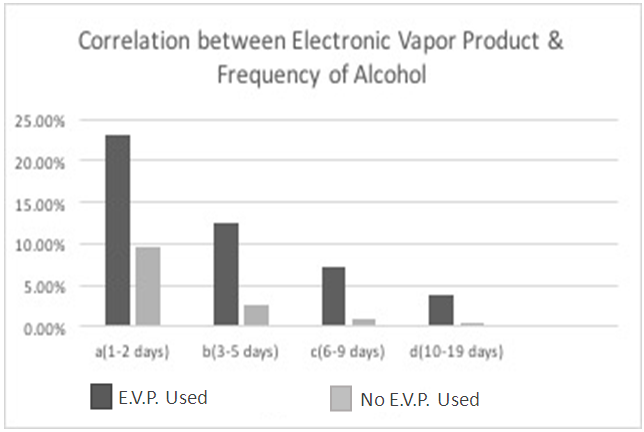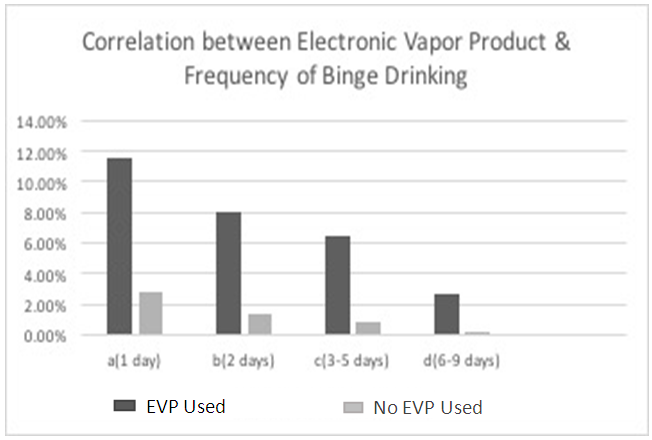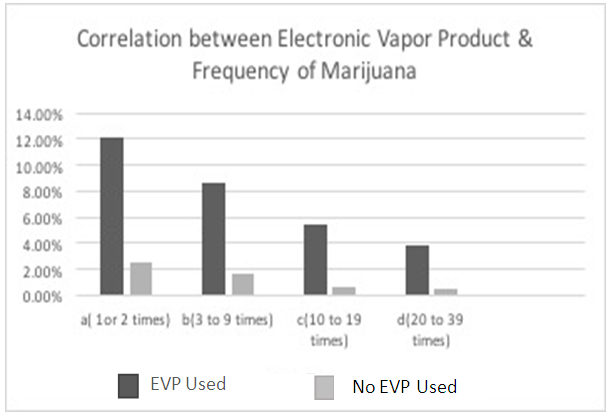-
Paper Information
- Paper Submission
-
Journal Information
- About This Journal
- Editorial Board
- Current Issue
- Archive
- Author Guidelines
- Contact Us
Public Health Research
p-ISSN: 2167-7263 e-ISSN: 2167-7247
2016; 6(5): 143-147
doi:10.5923/j.phr.20160605.03

Are Electronic Vapor Products New Gateway Drugs to Other Substance Abuse among High Schoolers?
Praphul Joshi, Mercedes Overton, Kayla Cole
Department of Health and Kinesiology, Lamar University, Beaumont TX, USA
Correspondence to: Praphul Joshi, Department of Health and Kinesiology, Lamar University, Beaumont TX, USA.
| Email: |  |
Copyright © 2016 Scientific & Academic Publishing. All Rights Reserved.
This work is licensed under the Creative Commons Attribution International License (CC BY).
http://creativecommons.org/licenses/by/4.0/

Electronic vapor products use is a significant issue in high school students (young youth). This study is based on a national survey of high school students (Youth Risk Behavior Survey – YRBS) regarding the use of electronic vapor products and its correlation with other substance abuse (use of alcohol, binge drinking episodes and marijuana use). Results of this study showed those who did not use electronic vapor products are more likely to abstain from alcohol and marijuana. Those who did not use electronic vapor products are less likely to binge drink as well. Both use and frequency of other substance abuse were highly correlated with electronic vapor use. Future interventions should include targeting electronic vapor products as it has overtaken cigarette smoking among high school students.
Keywords: Tobacco, Alcohol, High school students, Electronic Vapor Products, Marijuana
Cite this paper: Praphul Joshi, Mercedes Overton, Kayla Cole, Are Electronic Vapor Products New Gateway Drugs to Other Substance Abuse among High Schoolers?, Public Health Research, Vol. 6 No. 5, 2016, pp. 143-147. doi: 10.5923/j.phr.20160605.03.
1. Introduction
- Studies have found that people who smoke are much more likely to drink, and people who drink are much more likely to smoke [1]. These substances often are used together. Many studies have found that tobacco use does relate to alcohol use. Even though since 2011 cigarette smoking has decreased the other use of tobacco products have increased. Each day in the United States, more than 3,200 youth aged 18 years or younger smoke their first cigarette, and an additional 2,100 youth and young adults become daily cigarette smokers [2]. About 9 of every 100 high school students (9.3%) reported in 2015 that they smoked cigarettes in the past 30 days [2].Alcohol consumption among youth seem to begin at the early ages in life at the age 14. The 2013 Youth Risk Behavior Survey (YRBS) found that among high school students, during the past 30 days 35% drank some amount of alcohol, 21% binge drank, 10% drove after drinking alcohol, and 22% rode with a driver who had been drinking alcohol [3]. On average, underage drinkers consume more drinks per drinking occasion than adult drinkers [4]. Alcohol consumption and tobacco use are closely linked behaviors. Thus, not only are people who drink alcohol more likely to smoke (and vice versa) but also people who drink larger amounts of alcohol tend to smoke more cigarettes. Furthermore, patients diagnosed with dependence on one of the drugs also are commonly diagnosed with dependence on the other drug [5].Electronic vapor products (EVP) also known as Electronic Cigarettes, E-cigarettes or E-cigs, is an electronic device that vaporizes flavored liquid which is mixed with nicotine and other chemicals which is inhaled by the user. EVP use has been growing in the youth since 2011 [6]. As of 2015 EVP use among high school students has increased, surpassing cigarette use and alcohol use. EVP use among high school students tripled from 2013-2014, according to the data published from the CDC and Prevention and the U.S. Food and Administration’s Center for Tobacco Products [6]. The 2014 National youth tobacco survey show that current E-cigarette use in the past 30 days among high school students increased from 4.5% in 2013 to 13.4% in 2014 [5]. Total went from 660,000 to 2 million students [5]. CDC Director Tom Frieden quoted saying” We want parents to know nicotine is dangerous no matter what form it’s in including, E-cig, cigars, or hookahs” [7].With these essential findings it is viable that we find and compare the increase of EVP use and compare to findings of alcohol use, tobacco, and other drug products that are high among high school students.
2. About the Study
- The main objective of the study was to evaluate the correlation between electronic vapor products and alcohol use, binge drinking episodes and marijuana use among high school students. This study was based on the national YRBS data from 2015, of high school students. The question related to electronic vapor products was first asked in 2015 – and this will be one of the first few studies that has analyzed the effects of electronic vapor products on other substance abuse.
3. Methodology
- Researchers retrieved 2015 YRBS data, which was collected nationally from high school students 9th through 12th grade. The sample for this study included 15,624 students of which, males (n = 7757, 49.6%) and females (n = 7749, 49.6%) were evenly distributed. With regard to race, the sample consisted of 55.5% Caucasians (n = 8666), African Americans (14.3%) and Others (30.2%). Of the total sample, 32.8% (n = 5128) reported being Hispanic or Latino in origin. The age-group of the participants varied from 14 to 18 years. The study was based on the use of different substance abuse by underage youth including alcohol, binge drinking, and tobacco products. Pearson Chi-squares, and Gamma coefficients were calculated to determine significant findings. All tests for significance were based on p < 0.05.
4. Results
- Figure 1. indicates the correlation between Electronic Vapor Product and abstaining from alcohol use, binge drinking episodes and marijuana use. Those who did not use electronic vapor products were more likely to abstain from alcohol. They were less likely to binge drink and also less likely to indulge in marijuana. All three analyses were statistically significant (p< 0.01).
 | Figure 1. Correlation between EVP use and abstaining from and other substance abuse (N = 15,624; p < 0.001) |
 | Figure 2. Correlation between EVP and frequency of alcohol consumption (N = 15,624; Chi = 3333.5; p < 0.001) |
 | Figure 3. Correlation between Electronic Vapor Product & Frequency of Binge Drinking (N = 15,624; Chi = 2865.1; p < 0.001) |
 | Figure 4. Correlation between Electronic Vapor Product & Frequency of Marijuana (N = 15,624; Chi = 3522.3; p < 0.001) |
5. Discussion
- This is one of the first few studies to show comparisons and difference between marijuana use, alcohol use and binge drinking episodes with regard to electronic vapor product use based on the national YRBS data. All findings were significant at p < 0.01 level. The amount of significance, especially on a large dataset provides a strong evidence regarding the effects of electronic vapor product use among youth.Studies have shown that tobacco use has decreased over the years. But the use for E-cigarettes have increased dramatically over past 5 years. Starting in 2009 cigarette use had decreased in high school students about more than 15%. Of those who did smoke cigarettes it was determined that males were more likely to smoke than female students. Most can say the reason for decline in tobacco use is due to other types of drugs out there that students can get more easy access too. In the study it showed as well as tobacco use decreased the consumption of alcohol increased.AlcoholUnderage drinking is a huge problem in high schools. Between 2009-2015 females were more likely than males to drink alcohol. The main concern is binge drinking. Excessive drinking is responsible for more than 4,300 deaths among underage youth each year, and cost the U.S. 24 billion in economic cost in 2010 [8]. On average youth drinkers consume more drinks than adult drinkers, and more than 90% of this alcohol is consumed in the form of binge drinking [6]. In the 2013 YRBS survey it found that in the past 30 days 35% drank some type of alcohol and 21% binge drank. Within the past month, more than three out of 10 high school seniors report drinking some alcohol and one in six have engaged in “binge drinking” daily in the past two weeks [9]. MarijuanaMajority of high school seniors do not think occasional marijuana smoking is harmful, with only 31.9 percent saying that regular use puts the user at great risk compared to 78.6 percent in 1991 [10]. Past-month use of smoked marijuana remained steady among 10th graders at 14.8 percent, and 12th graders at 21.3 percent Six percent of 12th graders report daily use of marijuana [10]. However, the survey highlighted continuing concerns over the high rate of electronic cigarette (e-cigarette) use and softening of attitudes around some types of drug use, particularly a continued decrease in perceived harm of marijuana use [10].Electronic Vapor UseSince 2015 there is more electronic vapor use than of cigarette use in high school students. As indicated from this study findings, there is an increase in alcohol, binge drinking and marijuana use if using electronic vapor products. And as other street drugs are available to students due to easier access there is an increase in marijuana use if a high school student is an electronic vapor product user [11]. Electronic vapor products use poses new challenges according to the results shown by the CDC and Prevention. The 2015 survey reported that 24% of high school students report using electronic vapor products during the past 30 days. Current use of electronic vapor products increased among high school students from 2011-2015 [12]. The reason for this increase would be due to the youth having easier access to the product. Sometimes proper identification is not required to purchase vapor products, because they are considered not harmful [13]. Policy makers should recognize that electronic vapor products are becoming a gateway to use other drugs such as marijuana among youth.Other studies conducted relating to E-cigarette useDifferent studies have been conducted on the use of electronic vapor products. A recent study on E-cigarette use and smoking cessation indicated that e-cigarettes elevates cravings from other drugs [14, 15]. Another study highlighted issues that point to duration, frequency use, and device type for electronic vapor products [16]. Since this past year studies based on electronic vapor products have increased, due to its increasing number among youth. Reason for higher use of these products could be due to youth perception that the products are least harmful. Vapor products contain nicotine and the doses can be significantly greater than a regular cigarette. Also, it has been easier for youth to access these products as most places do not enforce identification or age-proof check for purchase. In ten states it is legal for minors to buy and smoke electronic vapor products. The e-cigarettes are popular among teens with flavors like fruit loops and starburst. They are sold just about everywhere: vape shops, gas stations and even grocery stores. A recent study by the University of Michigan shows more than twice as many 8th-through 10th-graders reported using e-cigarettes as those who reported using tobacco cigarettes.With Electronic Cigarettes being fairly new, it is still a growing trend. Amongst adults many have used Electronic cigarettes as way to quit smoking cigarettes, and other substances seeing that it would be much healthier to use Electronic cigarettes. Results from several studies suggest recent rapid increases in e-cigarette use. Current cigarette smokers who had tried to quit in the past year (20.3%) were almost twice as likely as cigarette smokers who had not tried to quit (11.8%) to currently use e-cigarettes [17]. National Health Interview Survey in 2014, researchers found that 22 percent of people aged 18 to 24 years old use e-cigs. With compared to high school students who ever used the device it was higher than adults at 13.6% compared to adults at 12.6% [18]. With relation to other drugs cigarettes, other drug use, and marijuana use are higher in adults than the use of Electronic Cigarettes. Data is currently very limited with regard to correlation of vapor products with other drug abuse or risky behaviors. The question related to vapor products was first asked in YRBS during the 2015 survey and the results have been first published in 2016.
6. Conclusions
- This study showed significant correlations between electronic vapor product use with the use of alcohol, binge drinking and marijuana among high school students. The results indicate that electronic vapor products use is a contributor to other outlets used by high school students. Study findings should help policy makers to enforce strict regulations on vapor product sales and marketing. Since most tobacco-related interventions in the past have focused on cigarette smoking, new interventions should educate the youth on the dangers of electronic vapor products and abstaining from other drugs.
 Abstract
Abstract Reference
Reference Full-Text PDF
Full-Text PDF Full-text HTML
Full-text HTML